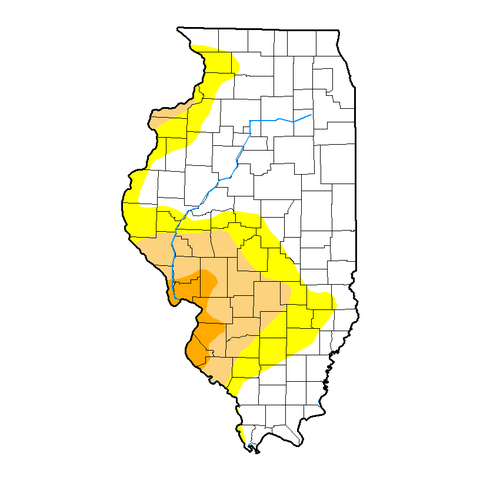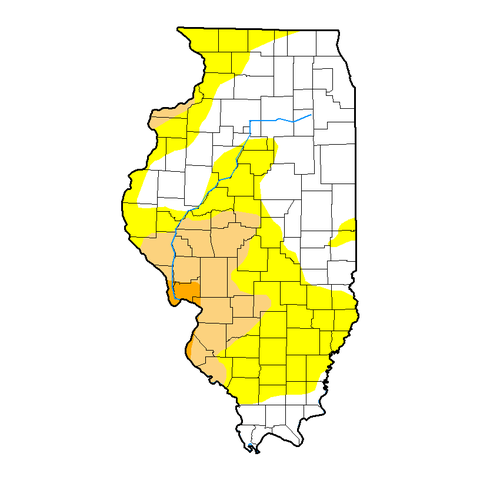About Your Fields 2-26-18
In this Issue:
- The Next Step in Building Your House
- Drought Update
- News that Caught Our Eye
The Next Step in Building Your House
In last week's issue we discussed how you can relate your crop protection plans as building a house, and the first step was getting a good foundation with a residual pre-plant herbicide program. The next step would be building your house's walls which would be the stalks of corn or stems of your soybean plants. The way that you would protect your stalks and stems would be to continue to kill any weeds that would emerge after your residual herbicide runs out. When the residual program actually starts to lose effectiveness depends on several factors; time, weather and rate applied. How long it will last (time) is pretty dependent on the rate you applied. If you have two fields side by side and you applied 1 quart of a product on one field and 2 quarts on the adjacent field, you should have a break in the field with 1 quart applied to it. This is where a post application of a herbicide becomes necessary in order to protect your stalks and stems. If you have weeds in your field, they will become competition for the available nutrients, water and especially sunlight. So, the logical question is what do I need to do next?
Step 1: Scout your field to see what is growing and when you should spray. In the years before 1996 when Roundup Ready soybeans became available, everyone scouted their fields to determine what weeds were growing. From 1996 to about 2006 you did not have to scout your fields as heavily, you just sprayed glyphosate. The biggest decision you had to make in the early years of glyphosate tolerant crops, was when to spray before the canopy closed. Once the canopy closed you relied on the fact that the lack of sunlight would prevent any more weeds from growing. Around 2002, we started having trouble controlling some weed species with the "full" label rate of glyphosate. So, what did we do? We just sprayed a higher rate of glyposate. All that did is make those weeds resistant to a higher rate of glyphosate.
Step 2: Once yuou have determined what weeds are present, determine what you should add you glyphosate to help control problem weeds. Around 2006 it became necessary to start adding different products to your post emerge herbicide pass. At this time, we basically have reduced glyphosate to being an effective way to control grass and help on ccertain broadleaf weeds. In order to control weeds like waterhemp, lambsquarters and marestail we were going to have to add something to the mix. Products like Cadet, Callisto Laudis, Status and Synchrony as well as Cobra and Flexstar started to be put into the mix. All of these products attacked the weeds differently than glyphosate did. Last week I wrote about different modes of action in you herbicide program. What I really should have said was that you need to have different Sights of Action (SOA). When we are looking at how to set up a weed control program today, we look at how many different sites in a weed that a particular chemical will attack. Why do we do this? The greater the number of diffent sites you have, the less risk you will have of a weed potentially becoming resistant to a herbicide. If you look on Akron's chemical price sheet, the second to last column on the right side lists the different SOA for each of the chemicals.
Besides adding another Sight of Action for killing power, it is becoming increasing important to add more residual. In other words, to take action to keep the foundation strong. Adding group 15 herbicides such as Dual, Outlook, and Warrant are a great way of adding additional waterhemp and grass residual. Keep in mind that some herbicides added to kill weeds on the post side can also provide residual (such as Callisto, Laudis, Armezon, dicamba, and Flexstar). Always make sure the entire herbicide program is addressing all species in the your field.
Once you have determined what weeds are present in the field, and what you are going to add to the tank mix, there is another important factor you need to consider. What else will you put in the tank to help the chemicals work better and why? And that is what we will discuss next week.
Drought Update
In the February 12th issue of About Your Fields we talked about how even though we had just had 10 plus inches of snow in parts of Akron's trade territory we were considered to be in a drought. Since that time many of you have had more snow and even rain. We have had enough precipitation that the Illinois river is above flood stage. I wondered if any of those events would have any effect on the drought status of our area. I looked on the state website Illinois Drought Index and looked at the latest map. It looks like all of the precipitation has taken out of the area that is considered to be in a drought.


Drought Index as of February 20, 2018 Drought Index as of January 30, 2018
News That Caught Our Eye
With all the talk about the cost of raising corn in 2018, many of you might be looking at some alternatives on what to grow. A few people I have heard are thinking about growing soybeans on the same field as last year. That got me to start looking at what could be the problems with raising continuous soybeans. I mean we have been doing corn on corn for years. Would we encounter some of the same potential issues raising continuous soybeans? For example would we see some of the same problems like disease pressure, nutrient issues and other potential pitfalls we have with continuous corn. I did some research and found this article by a group of researchers from the University of Kentucky Management Tips for Continuous Soybean Production. One of the lead authors is Dr. Carl Bradley who used to be a professor at the University of Illinois. In this article it was stressed that one of the most important things to know when growing continuous soybeans in a field is how much Soybean Cyst Nematode (SCN) pressure is present. Once you have a handle of the SCN levels in a field, you need to realize that you will have to increase your seeding rate. Research has shown a decrease of 25% in stands in continuous soybean systems. There was also a 5% yield reduction according to the study. I encourage you to read the article if you are planning on planting soybeans 2 years in a row on a field.